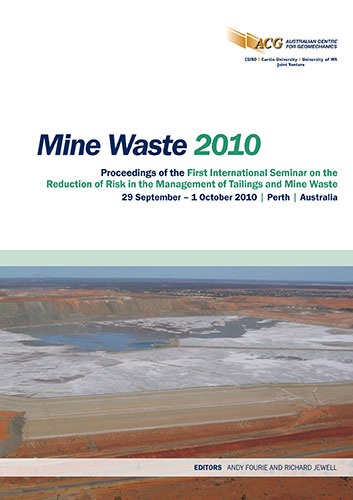Environmental compliance

|
Authors: Jones, H Paper is not available for download Contact Us |
DOI https://doi.org/10.36487/ACG_rep/1008_27_Jones
Cite As:
Jones, H 2010, 'Environmental compliance', in R Jewell & AB Fourie (eds), Mine Waste 2010: Proceedings of the First International Seminar on the Reduction of Risk in the Management of Tailings and Mine Waste, Australian Centre for Geomechanics, Perth, pp. 309-317, https://doi.org/10.36487/ACG_rep/1008_27_Jones
Abstract:
The Macquarie dictionary defines ‘compliance’ as ‘1. An act of conforming; acquiescing, or yielding. 2. base subservience.’ Does environmental compliance mean yielding to environmental forces, or does it mean being subservient to a human perception of the environment? How ‘environmental compliance’ may be defined by the various stakeholders in the mining industry, companies, governments and communities is considered in the light of their possible objectives in requiring ‘environmental compliance’. Examples of potentially conflicting environmental requirements in waste management are considered, particularly operational requirements such as minimal dust generation versus completion environmental compliance requirements of establishing a self-sustaining ecosystem or geomorphologically stable landform. Mechanisms available to establish standards for determining if environmental compliance has been attained are described. These include guidelines (company and government), which can range from detailed (tailings construction) to broad and general (closure strategies); codes of practice, Ministerial conditions and regulations are discussed. Some of the strengths and weaknesses these mechanisms are described, using examples from industry experience. The site specific nature of most mine waste management operations means that one approach cannot fit all situations and the fairness of having a solution acceptable in one operation, but not in another is discussed. Does strict compliance with a human perception of the environment and how it functions promote a ‘lowest common denominator’ approach? The potential technology restricting aspects of requiring ‘compliance’ is discussed and the alternative compliance requirements of ‘‘outcome’ compliance and ‘process’ compliance considered. The time frame for assessing environmental compliance is discussed. The potential use of simulation models as potential tools for assessing future environmental performance is considered. Moreover, it is concluded that ‘environmental compliance’ means conforming to the environment rather than simply acquiescing or yielding to man-made ‘rules’.
References:
Blight, G.E. and Amponsah-Da Costa, F. (1999) In search of the 1,000-year tailings dam slope, SA Civil Engineering,
October.
Brearley, J., Osborne, J. and Wright, I. (2000) Assessment procedures and end point criteria for arid mine waste rock
dumps. Report on MERIWA Project M277.
Gouvernement du Québec (1997) Guidelines For Preparing A Mining Site Rehabilitation Plan And General Mining Site
Rehabilitation Requirements, 61 p.
International Council on Mining and Metals (ICMM) (2008) Planning for Integrated Mine Closure, Toolkit, 82 p.
International Finance Corporation (IFC) (2007) Environmental, Health and Safety Guidelines, Mining, December,
2007, 28 p.
Jones, H. (2005) Future Directions – Developing a Code of Practice, in Proceedings Creating Cost Effective
Rockdumps and Stockpiles Seminar, Australian Centre for Geomechanics, Perth, 26–27 May 2005, Section 18.
Jones, H. (2008a) The Metamorphism of Dumps into Hills, in Proceedings of the First International Seminar on the
Management of Rock Dumps, Stockpiles and Heap Leach Pads, 2008, Australian Centre for Geomechanics,
pp. 267–277.
Jones, H. (2008b) Closure Objectives, Guidelines and Actual Outcomes, in Proceedings Third International Seminar on
Mine Closure, Mine Closure 2008, A.B. Fourie, M. Tibbett, I.M. Weiersbye, P. Dye (eds), Australian Centre for
Geomechanics, Perth, Australia, pp. 245–254.
Leading Practice Sustainable Development Program for the Mining Industry (2006) Mine Closure and Completion,
October 2006. Commonwealth of Australia, 63 p.
Loch, R.J. and Lowe, S.M. (2008) A Logical Framework for the Design, Construction and Rehabilitation of Mine Site
Waste Dumps, in Proceedings First International Seminar on the Management of Rock Dumps, Stockpiles and
Heap Leach Pads, Rock Dumps 2008, A.B. Fourie (ed), Australian Centre for Geomechanics, Perth, Australia,
pp. 257–267.
McPhail, G. and Rye, C. (2008) Comparison of the Erosional Performance of Alternative Slope Geometries, in
Proceedings First International Seminar on the Management of Rock Dumps, Stockpiles and Heap Leach Pads,
Rock Dumps 2008, A.B. Fourie (ed), Australian Centre for Geomechanics, Perth, Australia, pp. 277–289.
Myres, K.L., Espell, R. and Burke, K. (2001) Reclamation and Closure of the AA Heap Leach Pad at Barrick’s
Goldstrike Mine, SME Transaction.
Tongway, D.J. and Hindley, N.L. (2004) Landscape Function Analysis: procedures for monitoring and assessing
landscapes, CSIRO Sustainable Ecosystems, Canberra.
Waggitt, P. (1994) A review of worldwide practices for uranium mill tailings, Supervising Scientist for the
Commonwealth of Australia 1994. 52 p.
Willgoose, G.R. (2000) Geomorphology/Erosion, In Planning for Mine Closure, Australian Centre for Geomechanics,
Perth.
World Bank Group (1998) Pollution Prevention and Abatement Handbook, pp. 267–271.
Environmental compliance H. Jones
318 Mine Waste 2010, Perth, Australia
© Copyright 2025, Australian Centre for Geomechanics (ACG), The University of Western Australia. All rights reserved.
View copyright/legal information
Please direct any queries or error reports to repository-acg@uwa.edu.au
View copyright/legal information
Please direct any queries or error reports to repository-acg@uwa.edu.au